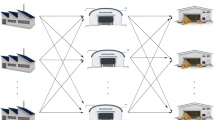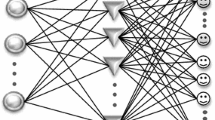Abstract
In this paper, a logistics network is investigated which includes multi-suppliers, collection centers, transfer stations, treatment stations, and products. For this purpose, a multi-objective mathematical programming model is proposed that minimizes the total costs including the fixed costs for opening facilities and transportation costs between facilities, minimizes the distance between each waste-generating facilities and transfer stations, maximizing the distance between treatment and disposal stations and customer zones, and maximizes the sum of the reliability of coverage for the potential facilities which will be open. In order to make the results of this paper more realistic, a case study in the iron and steel industry has been investigated. Besides, a new solution approach is proposed by combining fuzzy possibilistic programming, stochastic programming, and fuzzy multi-objective programming. Moreover, an imperialist competitive algorithm is proposed to obtain near optimal solution in comparison with other evolutionary algorithms. Finally, computational experiments are provided to demonstrate the applicability and suitability of the proposed model and solution approaches.


Similar content being viewed by others
References
Atashpas-Gargari E, Lucas C (2007) Colonial competitive algorithm. Congress on Evolutionary Computation, CEC, Piscataway
Chiu MC, Teng LW (2013) Sustainable product and supply chain design decisions under uncertainties. Int J Precis Eng Manuf 14(11):1953–1960
Guide VDR Jr, Wassenhove LNV (2009) The evolution of closed-loop supply chain research. Oper Res 57(1):10–18
Hong X, Wang Z, Wang D, Zhang H (2013) Decision models of closed-loop supply chain with remanufacturing under hybrid dual-channel collection. Int J Adv Manuf Technol 68(5–8):1851–1865
Jimenez M, Arenas M, Bilbao A, Rodriguez MV (2007) Linear programming with fuzzy parameters: an interactive method resolution. Eur J Oper Res 177:1599–1609
Kim Y (2013) Facility location for a hybrid manufacturing/remanufacturing system with carbon costs. Graduate theses and dissertations. Paper 13329
Lai YJ, Hwang CL (1992) A new approach to some possibilistic linear programming problems. Fuzzy Sets Syst 49:121–133
Lee JE, Chung KY, Lee KD, Gen M (2013) A multi-objective hybrid genetic algorithm to minimize the total cost and delivery tardiness in a reverse logistics. Multimed Tools Appl. doi:10.1007/s11042-013-1594-6
Leung Y (1988) Spatial analysis and planning under imprecision (Studies in Regional Science and Urban Economics). Elsevier, Amsterdam
Liu D (2013) Network site optimization of reverse logistics for E-commerce based on genetic algorithm. Neural Comput Appl. doi:10.1007/s00521-013-1448-1
Liu L, Huang GH, Liu Y, Fuller GA, Zeng GM (2003) A fuzzy-stochastic robust programming model for regional air quality management under uncertainty. Eng Optim 35(2):177–199
Mehrbod M, Tu N, Miao L, Wenjing D (2012) Interactive fuzzy goal programming for a multi-objective closed-loop logistics network. Ann Oper Res 201(1):367–381
Mohammadi M, Jolai F, Rostami H (2011) An M/M/c queue model for hub covering location problem. Math Comput Model 54:2623–2638
Mousavi SM, Vahdani B, Tavakkoli-Moghaddam R, Hashemi H (2014) Location of cross-docking centers and vehicle routing scheduling under uncertainty: a fuzzy possibilistic–stochastic programming model. Appl Math Model 38(7–8):2249–2264
Pishvaee MS, Torabi SA (2010) A possibilistic programming approach for closed-loop supply chain network design under uncertainty. Fuzzy Sets Syst 161:2668–2683
Sabzevari Zadeh A, Sahraeian R, Homayouni SM (2014) A dynamic multi-commodity inventory and facility location problem in steel supply chain network design. Int J Adv Manuf Technoly 70(5–8):1267–1282
Soleimani H, Seyyed-Esfahani M, Akbarpour Shirazi M (2013) Designing and planning a multi-echelon multi-period multi-product closed-loop supply chain utilizing genetic algorithm. The International Journal of Advanced Manufacturing Technology 68(1–4):917–931
Soleimani H, Seyyed-Esfahani M, Akbarpour Shirazi M (2013) A new multi-criteria scenario-based solution approach for stochastic forward/reverse supply chain network design. Ann Oper Res. doi:10.1007/s10479-013-1435-z
Soyster AL (1973) Convex programming with set-inclusive constraints: applications to inexact linear programming. Oper Res 21:1154–1157
Torabi SA, Hassini E (2008) An interactive possibilistic programming approach for multiple objective supply chain master planning. Fuzzy Sets Syst 159:193–214
Vahdani B, Razmi J, Tavakkoli-Moghaddam R (2012) Fuzzy possibilistic modeling for closed loop recycling collection networks. Environ Model Assess 17(6):623–637
Vahdani B, Tavakkoli-Moghaddam R, Jolai F, Baboli A (2012) Reliable design of a closed loop supply chain network under uncertainty: an interval fuzzy possibilistic chance-constrained model. Eng Optim. doi:10.1080/0305215X.2012.704029
Vahdani B, Tavakkoli-Moghaddam R, Modarres M, Baboli A (2012) Reliable design of a forward/reverse logistics network under uncertainty: a robust-M/M/c queuing model. Transp Res Part E 48(6):1152–1168
Wang HF, Hsu HW (2012) A possibilistic approach to the modeling and resolution of uncertain closed-loop logistics. Fuzzy Optim Decis Making 11(2):177–208
Wang J, Shu YF (2007) A possibilistic decision model for new product supply chain design. Euro J Oper Res 177:1044–1061
Zanjirani Farahani R, Hekmatfar M (2009) Facility location, concepts, models, algorithms and case studies. Springer, Berlin. doi:10.1007/978-3-7908-2151-2
Zhang Y, Song S, Zhang H, Wu C, Yin W (2012) A hybrid genetic algorithm for two-stage multi-item inventory system with stochastic demand. Neural Comput Appl 21(6):1087–1098
Zhou XC, Zhao ZX, Zhou KJ, He CH (2012) Remanufacturing closed-loop supply chain network design based on genetic particle swarm optimization algorithm. J Cent South Univ 19(2):482–487
Acknowledgments
The authors would like to acknowledge the partially financial support of Islamic Azad University, Qazvin Branch, Qazvin, Iran for this research.
Author information
Authors and Affiliations
Corresponding author
Rights and permissions
About this article
Cite this article
Vahdani, B., Dehbari, S., Naderi-Beni, M. et al. An artificial intelligence approach for fuzzy possibilistic-stochastic multi-objective logistics network design. Neural Comput & Applic 25, 1887–1902 (2014). https://doi.org/10.1007/s00521-014-1679-9
Received:
Accepted:
Published:
Issue Date:
DOI: https://doi.org/10.1007/s00521-014-1679-9




